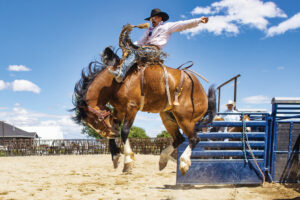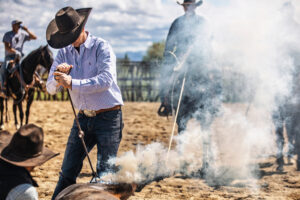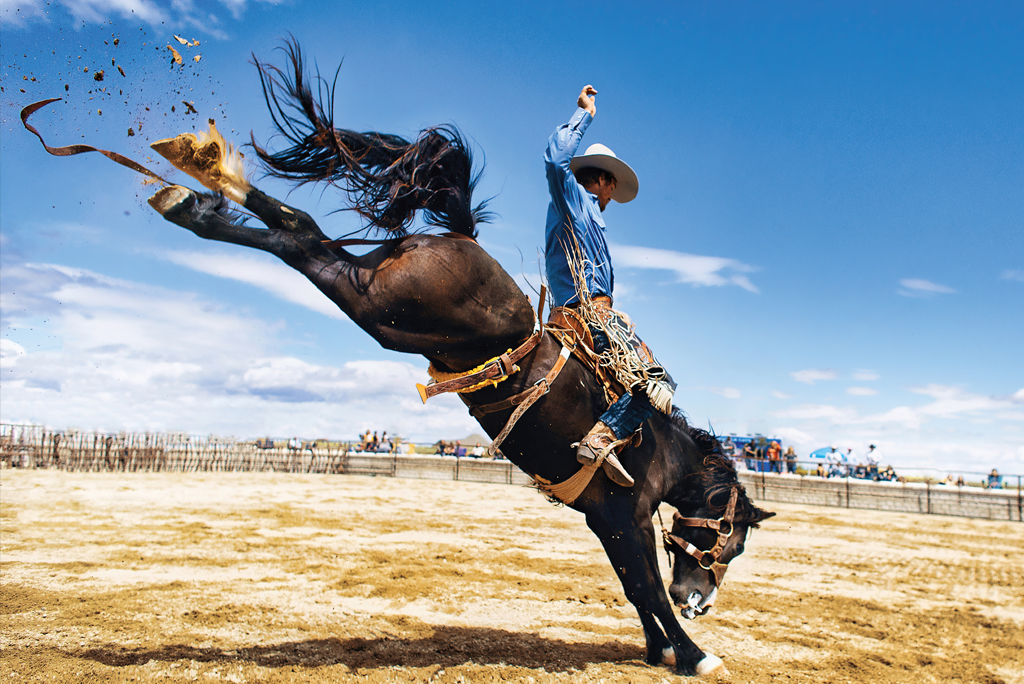The white-knuckle sport of rodeo bronc riding harkens back to the rough and tumble traditions of the Mexican ranch hands of the early 1800s.
These Mexican cowboys, or vaqueros, were expert horsemen that perfected the roping and riding skills required to round up lost or sick animals or break wild horses. During downtime between ranch work, the vaqueros would compete in rodears, which in Spanish means to encircle or round up, to see who stays on the orneriest horse or could rope a calf the fastest—the same skills that are seen in today’s rodeo competitions.
Eventually, rodear was introduced to cowboys in America, and ranch-versus-ranch competitions sprang up with events such as bronc and bull riding and roping contests.
Idaho started in rodeo history when the War Bonnet Roundup was first held in 1912 in Idaho Falls. The event is still strong, hosting 450 competitors each summer in front of more than 15,000 rodeo enthusiasts. Today, rodeo events—both pro and amateur—can be found in every corner of the state of Idaho.
Cowboys and cowgirls come from all over to compete in riding and roping, but where do the extraordinary animals come from?
Meet the Kings
Gene and Amanda King own King Rodeo Company, a rough stock contracting company that breeds and raises what some have called Idaho’s—and maybe even the West’s—finest bucking horses.
Making their home in Wilder, Idaho, near the Idaho-Oregon border, the Kings have about 250 horses of all ages—weanlings, yearlings, two- and three-year-olds, and the bareback and saddle broncs that are five or six years of age and older.

The white-knuckle sport of rodeo bronc riding harkens back to the rough and tumble traditions of the Mexican ranch hands of the early 1800s.
Between the 140 acres the Kings own in Wilder and a couple of thousand acres they lease in Wyoming, Utah, and Gem County, Idaho, there is plenty of land to breed and raise top rodeo stock.
“We aren’t the only rough stock breeders in Idaho, but I’d say we might be on the larger scale on numbers,” says Amanda. “And I would consider our breeding program award-winning. We’ve raised and sold a handful of horses that have gone on to the National Finals Rodeo (NFR) and have taken their cowboys to round wins.”
The NFR is the premier annual championship event hosted by the Professional Rodeo Cowboy Association. It is known as the world’s richest and most prestigious rodeo.
“Not everybody breeds their own horses; they buy horses we sell when we feel it’s not really working for us the way we want it to,” says Gene, who breeds 30 to 40 horses a year. Breeding and raising these horses enables him to produce broncs with the most desirable traits in a bucking horse.
In his horses, Gene looks for strong legs, a high kick, forward movement, rhythm and how they keep their head. “On the whole, I think the cowboys would say our horses are pretty good to get on and get some points. The goal is to give them the best shot to place.”
As a kid, Gene was involved with rodeo, but he never thought about raising rough stock. Later, he rodeoed with his mentor Jay Hoggan, who owned a smaller, amateur rodeo company and taught Gene how to handle the stock and run the operations. Gene bought out Hoggan in 2008 and started King Rodeo, which is now a stock contractor with the Professional Rodeo Cowboy Association (PRCA), the largest pro rodeo organization in the world. The PRCA sanctions events in the U.S., Canada, and Mexico.
It’s a Family Deal
Married since 2016, Gene and Amanda have rodeoed and raised bucking horses, bulls and barrel horses, plus their five kids: Grace, 22; Gwendolyn, 20; Georgia, 17; Gladys, 12; and Gatlin, 6; each of whom has inherited the rodeo spirit.
“All of them compete. The two older girls run barrels. Georgia, she’s in high school, and she made the national high school finals last year. Glady, she’s young, she’s in junior high, and she’s the same,” says Amanda.
“Gatlin is probably the most talented of us all,” she laughs. “He rides the biggest horse we have, named Bumpy. He’ll go out with me, and he can sort the horses. He opens up the gates. All the girls do, too; we sort and gather horses together. It’s a family deal.”
When asked about bronc riding, Amanda laughs and says, “Nobody in the family rides bucking horses, but we do have a boy coming up, so maybe.”
Solid Horses, Great Family
Kade Bruno, a saddle bronc rider who, in 2022, ranked 11th in the world and seventh in the NFR standings, has known the King family most of his life and has competed on their horses.
“Shoot, I’ve known Gene probably from when I was in eighth grade, and I’m 22 now. Gene has always had very, very good stock, and it’s only getting better,” he says.
Kade says he believes the Kings’ horses are the best in Idaho and some of the finest in the West.
“A lot of the buck comes from the mare, and Gene’s brood mares are some of the best, and he’s gone beyond measures to get great studs to cross these horses with. He takes pride in his horses and has worked hard to get where he’s at.
“They are good people, and they care more about taking care of the cowboys than anything. In a cowboy’s book, that means a lot when the contractors are looking out for you as well as their stock,” Kade explains.
The performance of the bucking bronc in the arena is judged and receives points, just like the rider. These points are added together to get the final total for the ride.
“My intention isn’t to buck off anyone,” says Gene. “We want the cowboys to come and ride and be happy. I want the highest scores we can get. It makes us look really good when riders ride.”
Amanda agrees, saying, “One good buck off is always cool, but we want those guys to come to ride our horses and make 90 points and win the rodeo.”
She talked proudly of one of her and Gene’s favorite horses, an “underdog” named Popeye.
“Last year, our first pro rodeo was in Loganville, Nevada. We have this mare, Popeye, and she’s so much smaller than our other bucking horses. Her ear is crooked, missing an eye, her face is kinda’ crooked, and she reminds me of a little Chihuahua, very small but fierce.
“She bucks, I mean really bucks! And Sage Newman, who ended fifth in world standings in saddle bronc, drew her last year at Loganville and ended up winning the rodeo on her with 89 ½ points. They tied the arena record on her on the Snake River Stampede last year as well,” Amanda says.
Amanda calls these broncs ‘majestic.’
“Some people think these horses are wild, but a lot of ours, you can go pet them in the pasture. But they also just like to buck. They’re born to do that. You breed your good bucking horses because they have the desire or the mentality to buck. They like it.
“I love them all, and I spend a lot of time with them, and I get very attached to them,” Amanda says. “Even on their bad days, I stand up for them and treat them like world champions.”
During a rodeo competition, all the broncs wear flank straps, a loose-fitting, double-padded sheepskin belt placed under their belly area that helps enhance the horses’ desire to buck.
“Flanks are like an aid to the bucking horses, much like cleats on the shoes of an athlete,” Amanda says. “An athlete can obviously play football or run the track with regular tennis shoes on, but cleats help them perform better. Same thing with the flank. It doesn’t make them buck; it just helps enhance them to buck a little bit better.”
Rodeo Culture
The Kings plan to go to 32 rodeos this year. “With our family, we do try and keep our rodeo trail in the Northwest, but I feel as our PRCA career grows, our rodeo ‘radius’ will grow as well,” says Amanda.
“If we’re the primary stock contractor, we take a semi-load of 34 head of horses. We have three pod trailers, one straight deck trailer carrying about 24 horses, and two big stock trailers.

Born to Buck
“Our daughter Gwendolyn drives trucks and hauls semis. Everybody we hire that rodeos with us is like family; they know us and our animals. We don’t hire anybody that we wouldn’t have at our dinner table. Everything is close-knit around here,” she says.
Keeping the horses safe is of utmost importance. So when the Kings bought their Wilder horse property, they tore out every fence, pasture and arena and started from scratch to make it safe for the horses.
“Everything here has been rebuilt with our animals in mind,” Amanda says.
Kade echoes Amanda, saying, “These horses are very special to the cowboys and contractors. It’s our way of life, and in a way, these horses are family.”
Ultimately, underneath the boots and spurs and the bells and whistles of rodeo, it’s about people who care about each other and their animals.
“Every night at a rodeo is like going to a high school reunion,” Gene says. “You get to see all your friends that you haven’t seen in a month or even six months. That’s where you meet everybody from all over. Shoot, it’s a pretty big melting pot, and even though we’re in a competition, everybody, for the most part, helps each other. There is a lot of comradery.”
Says Kade, “This life is short and surrounding yourself with great people and enjoying rodeo with people like that is pretty special.”


